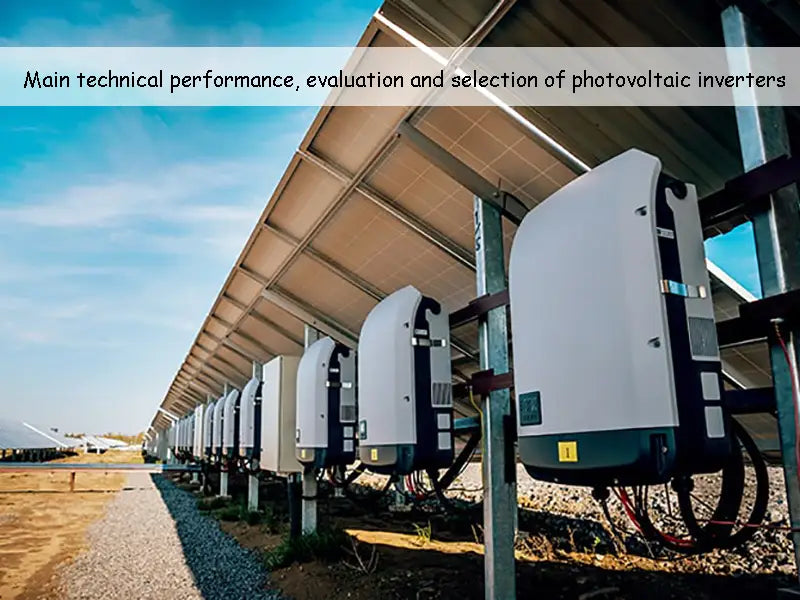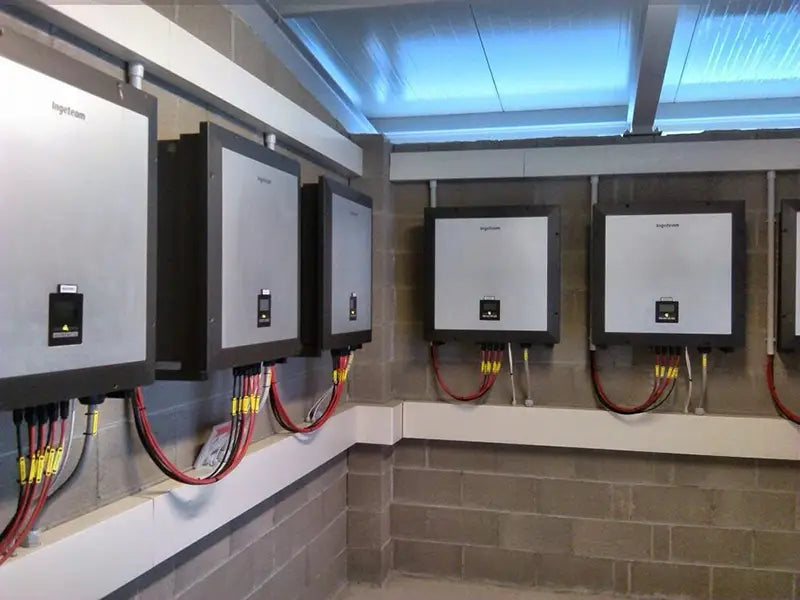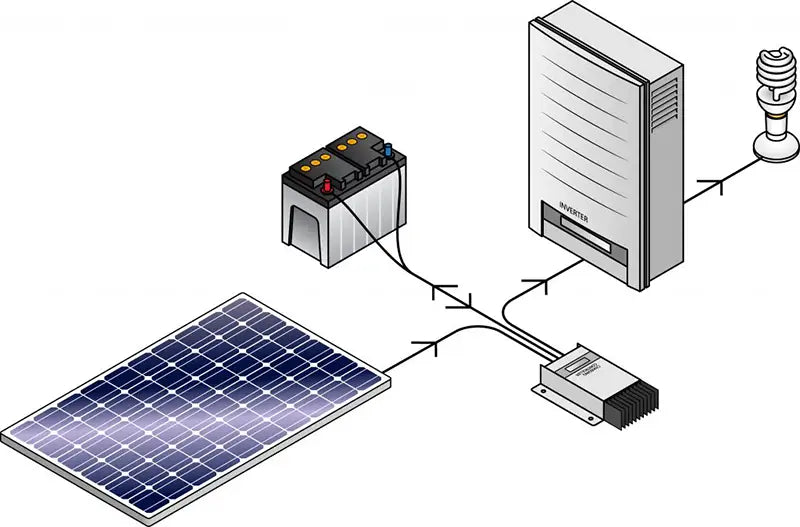
Main content:
1. Introduction to the technical performance of photovoltaic inverters
There are many basic parameters and technical conditions that characterize inverter performance. Here is only a brief description of some parameters often used in evaluating photovoltaic inverters.
(1) The rated output voltage of the photovoltaic inverters. Within the allowable fluctuation range of the specified input DC voltage, the rated output voltage indicates the rated voltage value that the inverter should output. The stable accuracy of the output rated voltage value is stipulated as follows:
①In steady-state operation, the voltage fluctuation range should have a limit, for example, its deviation should not exceed ±3% of the rated value.
②In the dynamic situation of load mutation or other interference factors, the output voltage deviation should not exceed ±8% or ±10% of the rated value.
(2) The unbalance of the output voltage of the photovoltaic inverters. Under normal working conditions, the three-phase voltage unbalance (the ratio of the reverse sequence component to the positive sequence component) output by the inverter should not exceed a specified value, expressed in %, generally 5% or 8%.
(3) The waveform distortion of the output voltage of the photovoltaic inverters. When the inverter output is a sine wave, the maximum allowable waveform loss or harmonic content should be specified. It is usually expressed by the total waveform distortion of the output voltage, and its value should not exceed 5% (single output allows 10%).
(4) The rated output frequency of the photovoltaic inverters. The frequency of the inverter output AC voltage should be a relatively stable value, usually 50Hz at the power frequency. The deviation under normal working conditions should be within ±1%.

(5) Load power factor of photovoltaic inverters. The load power factor characterizes the ability of the inverter to drive an inductive load. The load power factor is 0.7~0.9 (hysteresis) under sine wave conditions, and the rated value is 0.9.
(6) The rated output current (or rated output capacity) of the photovoltaic inverters. The rated output current represents the output current of the inverter within the specified load power factor range. Some inverter products give the rated output capacity, which is expressed in VA or kVA. The rated output capacity of the inverter is the product of the rated output voltage and the rated output current when the output power factor is 1 (ie pure resistive load).
(7) The rated output efficiency of the photovoltaic inverters. The efficiency of photovoltaic inverters are the ratio of output power to input power under specified working conditions, expressed in %. The efficiency of the photovoltaic inverter at the rated output capacity is the full-load efficiency, and the efficiency at 10% of the rated output capacity is the low-load efficiency.
(8) Protection of photovoltaic inverters.
①Overvoltage protection. For inverters without voltage stabilization measures, there should be output overvoltage protection measures to protect the load from damage from output overvoltage.
②Overcurrent protection. The over-current protection of the inverter should be able to ensure timely action when the load is short-circuited or the current exceeds the allowable value, so as to prevent it from being damaged by the surge current.
(9) Start-up characteristics of photovoltaic inverters. Start-up characteristics characterize the ability of the inverter to start with load and its performance during dynamic operation. The inverter should be guaranteed to start reliably under rated load.
(10) Noise of photovoltaic inverters. Transformers, filter inductors, electromagnetic switches and fans in power electronic equipment are all sound. When the inverter is in normal operation, its noise should not exceed 80dB, and the noise of a small inverter should not exceed 65dB.

2. Evaluation of photovoltaic inverters
In order to correctly select the photovoltaic inverters, the technical performance of the photovoltaic inverters must be evaluated. According to the influence of the photovoltaic inverters on the operating characteristics of the independent photovoltaic power generation system and the performance requirements of the photovoltaic power generation system for the photovoltaic inverters, the following items are essential for evaluation.
(1) The rated output capacity of the photovoltaic inverters. The rated output capacity characterizes the ability of the PV inverter to supply power to the load. Photovoltaic inverters with high rated output capacity can drive more electrical loads. However, when the load of the photovoltaic inverters are not purely resistive, that is, when the output power is less than 1, the load capacity of the photovoltaic inverters will be less than the given rated output capacitance value.
(2) The stability of the output voltage of the photovoltaic inverters. The output voltage stability characterizes the voltage regulation ability of the output voltage of the photovoltaic inverters. Most photovoltaic inverters product give the deviation of the output voltage of the photovoltaic inverters within the allowable fluctuation range of the input DC voltage, which is usually called the voltage regulation rate. A high-performance inverter should also give the deviation % of the output voltage of the inverter when the load changes from 0% to 100%, which is usually called the load regulation rate. The voltage regulation rate of a photovoltaic inverters with good performance should be ≤3%, and the load regulation rate should be ≤±6%.
(3) The overall efficiency of the photovoltaic inverters, the efficiency value of the photovoltaic inverters represent the size of its own power loss, usually expressed in %. For photovoltaic inverters with larger capacity, the full load efficiency value and low load efficiency value should also be given. The efficiency of the inverter below 1kW should be 80%-85%; the efficiency of the photovoltaic inverters of 1kW class should be 85%. %~90%; 10kW-class inverter efficiency should be 90%-95%; 100kW-class photovoltaic inverters efficiency should exceed 95%. The efficiency of photovoltaic inverters can improve the effective power generation and reduce the efficiency of photovoltaic power generation systems. The cost of electricity generation has a significant impact.
(4) Protection function of photovoltaic inverters. Over-voltage, over-current and short-circuit protection are the most basic measures to ensure the safe operation of the inverter. The well-functioning sine wave inverter also has functions such as undervoltage protection, phase loss protection and over-limit alarm.
(5) Start-up performance of photovoltaic inverters. The inverter should ensure reliable startup under rated load. High-performance photovoltaic inverters can be started at full load multiple times in a row without damaging power devices. For its own safety, small inverters sometimes use soft start or current limiting, which is an indispensable and basic evaluation item for selecting inverters for photovoltaic power generation systems. Other technical performances, such as inverter waveform distortion and noise level, are also very important for high-power photovoltaic power generation systems and grid-connected photovoltaic power plants.

3. Selection of photovoltaic inverters
When choosing photovoltaic inverters, in addition to the above five basic contents, the following points should also be paid attention to:
(1) Sufficient rated output capacity and overload capacity. The first consideration in the selection of photovoltaic inverters is that it must have enough rated capacity to meet the electrical power requirements of the equipment under the maximum load. For the inverter with a single device as the load, the self-selecting of its rated capacity is relatively simple. When the electrical equipment is a purely resistive load or the power factor is greater than 0.9, the rated capacity of the photovoltaic inverters can be selected to be 1.1-1.15 times the capacity of the electrical equipment. When the photovoltaic inverters use multiple devices as the load, the selection of the inverter capacity must consider the possibility of several electrical devices working at the same time. The technical term is called the "simultaneous number" of the load system.
(2) Higher voltage stability performance. In the independent photovoltaic power generation system, the battery is used as the energy storage device. When the battery with a nominal voltage of 12V is in the floating charge state, the terminal voltage can reach 13.5V, and the short-term overcharge state can reach 15V. When the battery is discharged with negative charge, the terminal voltage can drop to 10.5V or lower. The fluctuation of the battery terminal voltage can reach about 30% of the nominal voltage. This requires the photovoltaic inverters to have good voltage regulation performance to ensure that the photovoltaic power generation system is powered by a stable AC voltage.
(3) High efficiency or higher efficiency under various loads. The high efficiency of the coin machine is a distinctive feature of photovoltaic inverters that distinguish them from general-purpose inverters. The actual efficiency of a 10kW-class general-purpose photovoltaic inverters are only 70%~80%. When it is used in a photovoltaic power generation system, it will bring about 20%~30% of the total power loss. In the design of photovoltaic inverters, special attention should be paid to reducing its own power loss to improve the efficiency of the whole machine. This is an important measure to improve the technical and economic indicators of photovoltaic power generation systems. In terms of overall machine efficiency, the requirements for inverters dedicated to photovoltaic power generation are: the rated load efficiency of inverters below kW level is 80%~85%, and the low load efficiency is 65%~75%: the rated load efficiency of 10kW level inverters It is 85%~90%, and the low load efficiency is 70%~80%.

(4) Good over-current protection and short-circuit protection functions. During the normal operation of the photovoltaic power generation system, the overcurrent or short circuit of the power supply system caused by load failure, personnel misoperation and external interference is completely possible. Photovoltaic inverters are the most sensitive to overcurrent and short circuit in external circuits, and are the weakest link in photovoltaic power generation systems. Therefore, when choosing photovoltaic inverters, it must be required to have a good self-protection function against overcurrent and short circuit. This is the key to improving the reliability of photovoltaic power generation systems at present.
(5) Maintenance of photovoltaic inverters. It is normal for a high-quality photovoltaic inverters to fail due to component failure after several years of operation. In addition to a good after-sales service system, manufacturers are also required to have good maintainability in terms of inverter production process structure and component selection. For example, the damaged components should have sufficient spare parts or be readily available, and the interchangeability of components should be good. In terms of process structure, components should be easy to disassemble and replace. In this way, even if the inverter fails, it can be quickly maintained and returned to normal.
Read more: Classification and characteristics of inverters for photovoltaic power generation systems
















